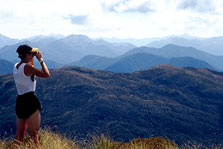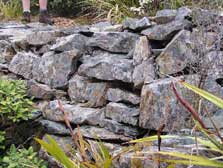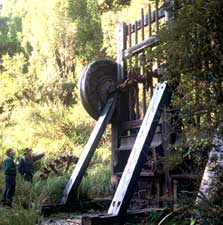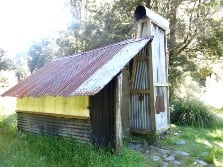Historic Croesus Track
Introduction
Croesus Track is one of the finest surviving examples of a miners' track on the West Coast. Visitors can also experience what life was like for miners by staying in historic Croesus Top Hut, or by visiting the Garden Gully Hut.Originally constructed in 1881, it is an old mining trail through the forest with many historic sites along the walk. The Croesus Track is one of the best surviving examples of a pack track in New Zealand.
In the early days of European settlement tracks known as ‘pack tracks’, ‘bridle paths’ or ‘bullock roads’ were built to open up the back blocks for mining, farming, tourism and other commerce.

View of Paparoa Range from Croesus Knob
Horses and bullocks were commonly used to access timber and mining sites, as well as transporting goods and equipment throughout the country. Many of the roads we use today started life as one of these early tracks.
Gold mining in the Grey Valley

Much of the stonework has remained intact thanks to the fine craftmanship
When gold was found at Blackball Creek in 1864, miners formed a rough track up the creek, through what was known as ‘some of the roughest country ever travelled by man’ in the hopes of striking it rich.
Over 18 years from 1881 to 1899, this early track was slowly replaced by a pack track, now known as the Croesus track. Access was firstly improved to take miners to the Clarke Creek gold diggings, then through to the Blackball Creek forks, finally taking the track right through to miners’ gold claims in the Paparoa ranges.

Garden Gully Battery
Skilled craftmanship
The track was skilfully built, using various traditional building techniques such as stonework and cuttings. It required ingenious engineering solutions to tackle problems created by the steep slopes and rugged country.
Today the track survives in much of its original condition thanks to the skilled craftsmanship of early pioneers and the stable nature of the terrain.
Historic relics
Today the 2 day trail is enjoyed by trampers and mountain bikers who traverse the rugged bush clad terrain to open tops, and pass relics such as the 19th century alluvial workings and the impressive quartz mining remains at the Garden Gully Battery site. They can admire the fine workmanship used to build the cuttings, embankments and stonework which are displayed along the track.
Visitors can also experience what life was like for miners by visiting:
- historic Croesus Top Hut
- historic Garden Gully Hut.
You can visit these huts but you cannot stay overnight at them. This is to help preserve these historic places.
Historic Garden Gully Hut
Garden Gully Hut was built during the 1930s slump by men prospecting for the Government or employed on a subsidised gold scheme. It is a significant historic site - the sole survivor of five huts which stood in the Garden Gully during the 1930s.
The hut sits amid beech/podocarp forest in a grassy clearing with a stream nearby. You are not permitted to stay in the hut but you can camp on the adjacent grassy flats.

Garden Gully Hut
It contains bunks and has a large open fireplace with a corrugated iron chimney. It was fully restored in 2006, when the side walls were replaced by original treated calico.
The hut will be maintained to protect its historic fabric and minimise deterioration. A conservation plan has been prepared (Les Wright, June 1998) to guide its management. A hardcopy of this plan is available at the Greymouth-Manwheranui DOC Area Office.
The surrounding area
About 10-15 minutes walk from Garden Gully Hut is the impressive Garden Gully Battery Site.
An additional 10 minutes walk from the Garden Gully Battery turn-off is the Garden Gully Mine. This mine was owned by Gerald Perotti, the only one who had the legal right to move supplies from the Smoko-ho car park to the Garden Gully Mine. The mine was closed by 1906 because of lack of gold return. At the mine site you will see old railway lines collapsed from the tramway and other historic remains.
Historic Croesus Top Hut
The hut was likely to have been built during the 1930s depression when gold prospectors worked on the Paparoa Tops, however, there could have been an earlier hut on the site. The hut has corrugated iron cladding and is timber lined. Inside the hut are a table, three sacking bunks and an open fireplace.
To preserve its historic fabric, you’re not allowed to stay overnight in Croesus Top Hut. This helps prevent damage to the hut.
DOC restored the Top Hut in 1999 as the hut was to the point of near collapse.
